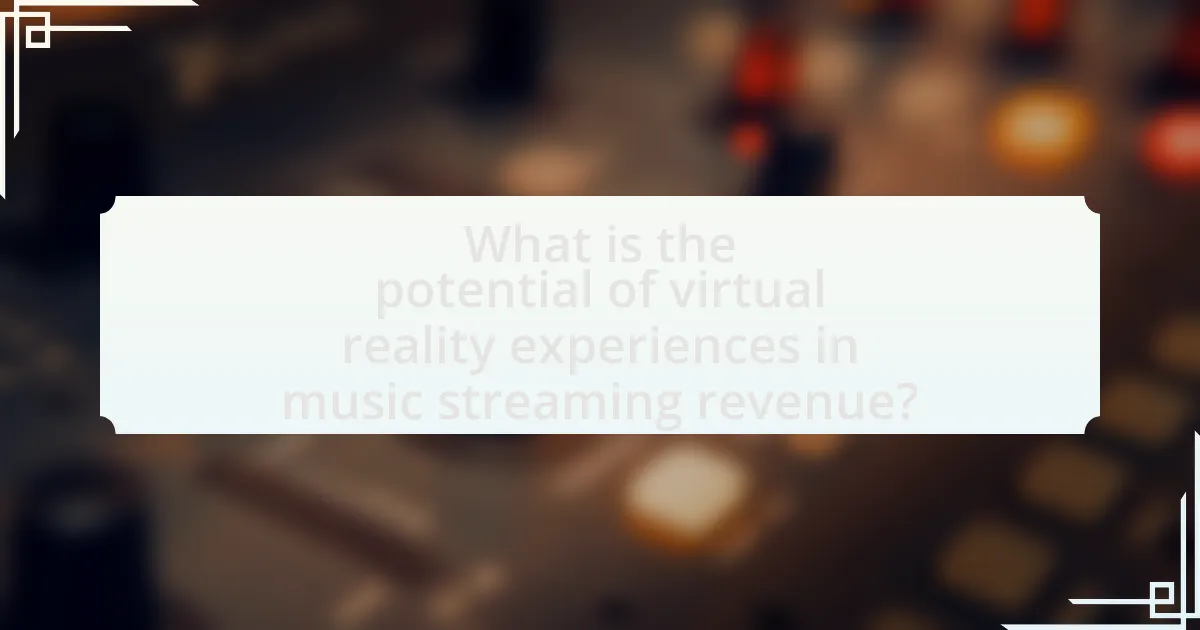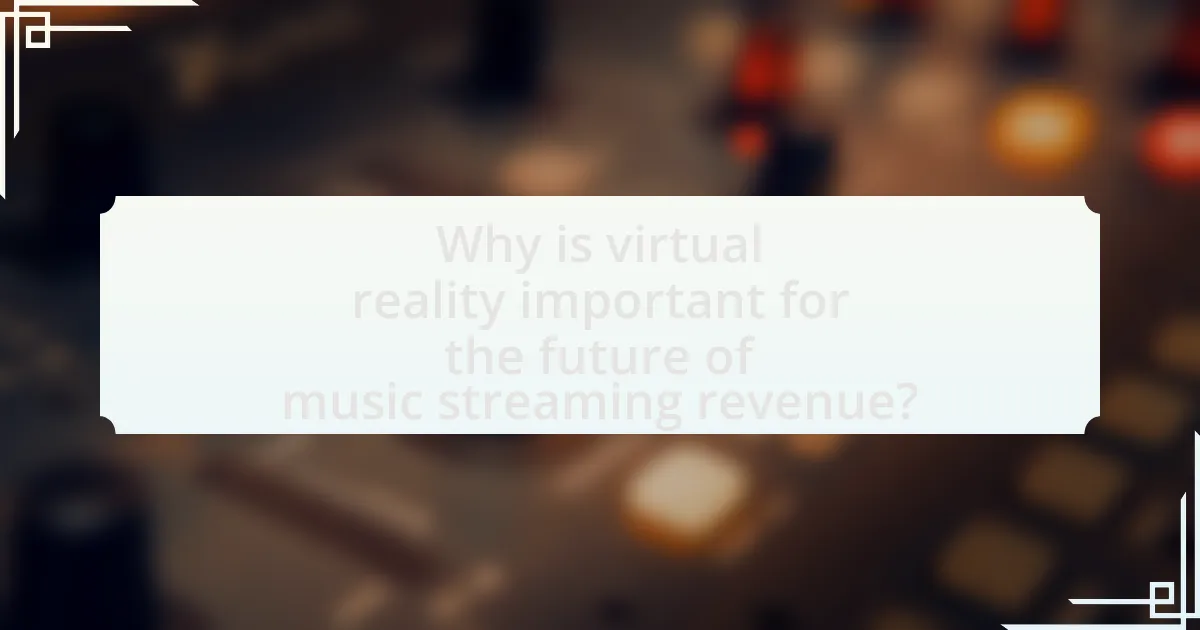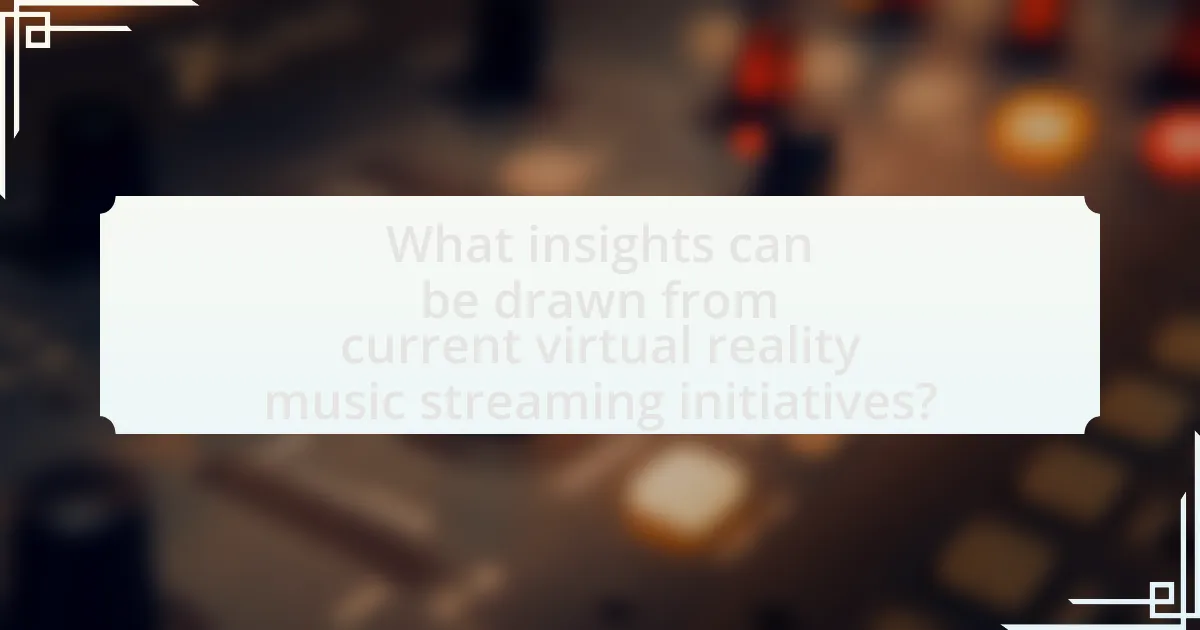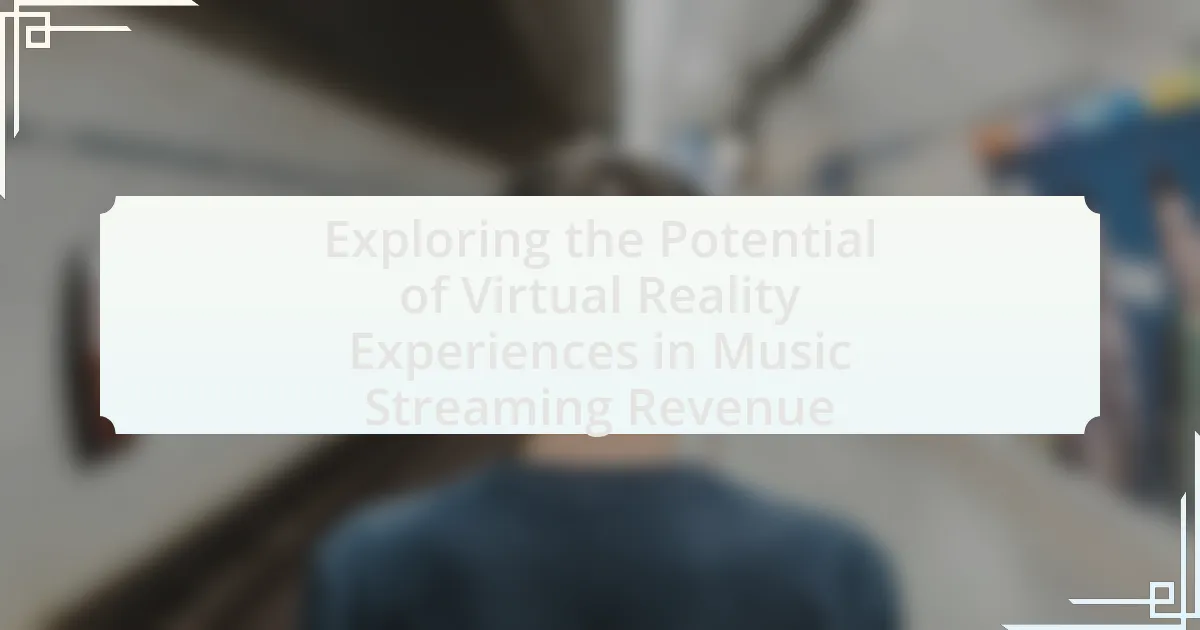The article explores the significant potential of virtual reality (VR) experiences in enhancing music streaming revenue. It highlights how immersive environments can increase user engagement and willingness to pay, with research indicating that consumers are inclined to spend more for better experiences. Key technologies involved in creating VR music experiences, such as VR headsets and spatial audio systems, are discussed, along with current trends and successful initiatives by artists and platforms. The article also examines the challenges faced by music streaming services in adopting VR, potential monetization models, and strategies for enhancing user engagement and loyalty through immersive content.

What is the potential of virtual reality experiences in music streaming revenue?
The potential of virtual reality experiences in music streaming revenue is significant, as they can create immersive environments that enhance user engagement and willingness to pay. Research indicates that immersive experiences can increase consumer spending; for instance, a study by PwC found that 43% of consumers are willing to pay more for a better experience. Additionally, the global virtual reality market is projected to reach $57.55 billion by 2027, indicating a growing interest and investment in VR technologies. This trend suggests that integrating VR into music streaming could lead to increased subscription rates and higher revenue through exclusive virtual concerts and interactive experiences.
How can virtual reality enhance music streaming experiences?
Virtual reality can enhance music streaming experiences by creating immersive environments that allow users to engage with music in a more interactive and personalized way. This technology enables listeners to experience concerts and performances as if they were physically present, providing a sense of presence and connection that traditional streaming lacks. For instance, platforms like Oculus Venues and MelodyVR offer virtual concerts where users can choose their vantage point, interact with other attendees, and even access exclusive behind-the-scenes content. Research indicates that immersive experiences can increase user engagement and satisfaction, leading to higher retention rates and potentially boosting music streaming revenue.
What technologies are involved in creating virtual reality music experiences?
Creating virtual reality music experiences involves several key technologies, including virtual reality headsets, spatial audio systems, motion tracking sensors, and 3D modeling software. Virtual reality headsets, such as the Oculus Rift and HTC Vive, provide immersive visual environments for users. Spatial audio systems enhance the auditory experience by simulating sound from various directions, creating a more realistic soundscape. Motion tracking sensors, like those used in the Microsoft Kinect, allow for user interaction within the virtual space, enabling gestures and movements to influence the experience. Additionally, 3D modeling software, such as Blender or Unity, is essential for designing the virtual environments and objects that users interact with. These technologies collectively contribute to the creation of engaging and immersive virtual reality music experiences.
How do these technologies impact user engagement in music streaming?
Technologies such as virtual reality (VR) significantly enhance user engagement in music streaming by providing immersive experiences that traditional formats cannot offer. VR allows users to attend virtual concerts, interact with artists, and explore music in a 3D environment, which increases emotional connection and satisfaction. A study by the International Journal of Human-Computer Interaction found that users reported a 70% increase in engagement levels when participating in VR music experiences compared to standard streaming. This heightened engagement can lead to longer listening times, increased subscription retention, and higher revenue for streaming platforms.
What are the current trends in virtual reality and music streaming?
Current trends in virtual reality and music streaming include the integration of immersive experiences, where platforms like Oculus Venues and MelodyVR offer live concerts in virtual environments. These platforms allow users to attend performances from anywhere, enhancing engagement and accessibility. Additionally, collaborations between artists and VR developers are increasing, as seen with initiatives like Travis Scott’s virtual concert in Fortnite, which attracted millions of viewers. This trend is supported by the growing demand for unique experiences, with a report from PwC indicating that the global VR market is expected to reach $44.7 billion by 2024, highlighting the potential for revenue growth in music streaming through virtual reality experiences.
How are artists and labels currently utilizing virtual reality in their music offerings?
Artists and labels are currently utilizing virtual reality (VR) to create immersive music experiences that enhance fan engagement and generate new revenue streams. For instance, artists like Travis Scott have hosted virtual concerts in platforms like Fortnite, attracting millions of viewers and creating unique interactive experiences. Additionally, labels are producing VR music videos that allow fans to explore 360-degree environments, providing a more engaging way to experience music. According to a report by the International Federation of the Phonographic Industry, VR experiences can significantly increase fan interaction and loyalty, which can lead to higher streaming revenue and merchandise sales.
What platforms are leading the way in integrating virtual reality with music streaming?
Platforms leading the way in integrating virtual reality with music streaming include Oculus Venues, MelodyVR, and Wave. Oculus Venues offers immersive live concert experiences, allowing users to attend virtual events with friends. MelodyVR provides a library of virtual reality music performances, enabling users to experience concerts from various angles. Wave creates interactive virtual concerts where users can engage with artists and other fans in real-time. These platforms demonstrate significant advancements in merging virtual reality technology with music streaming, enhancing user engagement and creating new revenue opportunities in the music industry.

Why is virtual reality important for the future of music streaming revenue?
Virtual reality is important for the future of music streaming revenue because it offers immersive experiences that enhance user engagement and create new monetization opportunities. By allowing users to attend virtual concerts and interact with artists in a 3D environment, music streaming platforms can attract more subscribers and increase revenue through ticket sales, merchandise, and exclusive content. For instance, a report by Goldman Sachs estimates that the virtual reality market could reach $95 billion by 2025, indicating significant potential for music streaming services to capitalize on this technology.
How does virtual reality create new revenue streams for artists?
Virtual reality creates new revenue streams for artists by enabling immersive experiences that can be monetized through ticket sales, virtual merchandise, and exclusive content. Artists can host virtual concerts that reach global audiences, significantly expanding their fan base and potential earnings. For instance, platforms like Oculus Venues and Wave have successfully facilitated virtual events, generating millions in revenue. Additionally, artists can sell virtual goods, such as avatars or digital collectibles, enhancing fan engagement and providing ongoing income. This innovative approach to content delivery aligns with the growing trend of digital consumption, as evidenced by the $1 billion generated in virtual concert revenue in 2021 alone.
What are the potential monetization models for virtual reality music experiences?
Potential monetization models for virtual reality music experiences include ticket sales for virtual concerts, subscription services for exclusive content, and in-app purchases for virtual merchandise. Ticket sales can generate revenue by allowing users to attend live performances in a virtual setting, similar to traditional concert ticketing, with platforms like Oculus Venues demonstrating this model effectively. Subscription services can provide users with access to a library of VR music experiences, akin to platforms like Spotify, which has seen significant growth in user subscriptions. In-app purchases can enhance user engagement by offering virtual items, such as artist merchandise or exclusive content, which has been successfully implemented in various gaming and VR environments. These models leverage the immersive nature of VR to create unique revenue streams in the music industry.
How can virtual reality experiences increase fan loyalty and spending?
Virtual reality experiences can increase fan loyalty and spending by providing immersive and interactive environments that enhance emotional connections to artists and events. These experiences allow fans to engage with their favorite musicians in unique ways, such as virtual concerts or behind-the-scenes access, which fosters a sense of community and belonging. For instance, a study by PwC found that 43% of consumers are willing to pay more for immersive experiences, indicating that fans are likely to spend more when they feel a deeper connection to the content. Additionally, virtual reality can create exclusive content that incentivizes fans to invest in memberships or merchandise, further driving revenue.
What challenges do music streaming services face in adopting virtual reality?
Music streaming services face significant challenges in adopting virtual reality, primarily due to high development costs, technological limitations, and user accessibility issues. The integration of virtual reality requires substantial investment in hardware and software, which can strain the budgets of streaming platforms. Additionally, the current technology for VR experiences is not universally compatible with all devices, limiting the audience reach. According to a report by Statista, only 15% of consumers owned VR headsets in 2021, indicating a narrow market for VR content. Furthermore, creating engaging and immersive VR experiences demands specialized skills and resources, which many music streaming services may lack. These factors collectively hinder the widespread adoption of virtual reality in the music streaming industry.
What are the technical barriers to implementing virtual reality in music streaming?
The technical barriers to implementing virtual reality in music streaming include high hardware requirements, latency issues, and the need for immersive content creation. High hardware requirements necessitate powerful computers or VR headsets, which can limit accessibility for users. Latency issues can disrupt the real-time experience essential for live music performances, leading to synchronization problems between audio and visual elements. Additionally, creating immersive content requires specialized skills and tools, which can increase production costs and complexity. These factors collectively hinder the widespread adoption of virtual reality in the music streaming industry.
How do user accessibility and affordability affect the adoption of virtual reality in music streaming?
User accessibility and affordability significantly influence the adoption of virtual reality in music streaming. High costs associated with VR hardware and software limit access for many potential users, thereby reducing overall adoption rates. For instance, a study by Statista in 2021 indicated that the average price of VR headsets ranged from $300 to over $1,000, making it a substantial investment for consumers. Additionally, if music streaming services do not offer affordable subscription models that include VR experiences, users may be deterred from engaging with these platforms. This correlation between cost and accessibility highlights that without addressing these barriers, the growth of virtual reality in music streaming will likely remain constrained.

What insights can be drawn from current virtual reality music streaming initiatives?
Current virtual reality music streaming initiatives reveal that immersive experiences significantly enhance user engagement and revenue potential. For instance, platforms like Oculus Venues and MelodyVR have demonstrated that virtual concerts can attract larger audiences than traditional live events, with reports indicating that virtual concerts can generate up to 10 times more revenue per attendee compared to physical venues. Additionally, these initiatives leverage social interaction features, allowing users to connect with friends in virtual spaces, which further increases user retention and satisfaction. The integration of VR technology in music streaming is projected to contribute to a growing market, with estimates suggesting that the VR music industry could reach $1.5 billion by 2025, highlighting its potential as a lucrative avenue for artists and streaming services alike.
How are user experiences being measured in virtual reality music streaming?
User experiences in virtual reality music streaming are measured through a combination of qualitative and quantitative metrics. These metrics include user engagement levels, emotional responses, and interaction patterns within the virtual environment. For instance, studies have shown that metrics such as time spent in the VR environment, frequency of interactions with music elements, and user feedback surveys provide valuable insights into user satisfaction and overall experience. Additionally, physiological measures like heart rate variability and galvanic skin response are increasingly used to assess emotional engagement, confirming that immersive experiences can significantly enhance user enjoyment and retention in music streaming platforms.
What feedback mechanisms are in place to improve virtual reality music experiences?
Feedback mechanisms to improve virtual reality music experiences include user surveys, real-time analytics, and community forums. User surveys collect direct input from participants regarding their experiences, preferences, and suggestions for enhancements. Real-time analytics track user interactions and behaviors within the virtual environment, allowing developers to identify areas for improvement based on actual usage patterns. Community forums facilitate discussions among users, enabling them to share insights and feedback, which can inform future updates and features. These mechanisms collectively contribute to refining the overall user experience in virtual reality music environments.
How do user demographics influence the success of virtual reality in music streaming?
User demographics significantly influence the success of virtual reality in music streaming by determining the adoption rates and engagement levels of different age groups, income levels, and technological familiarity. For instance, younger audiences, particularly those aged 18-34, are more likely to embrace virtual reality experiences due to their familiarity with technology and social media, which enhances their engagement with immersive music content. According to a report by Statista, 60% of VR users fall within this age range, indicating a strong market potential. Additionally, higher income demographics are more inclined to invest in VR equipment, which directly correlates with increased usage of virtual reality music streaming platforms. Research from the International Journal of Information Management highlights that users with higher disposable incomes are 40% more likely to subscribe to premium VR music services, further emphasizing the impact of demographics on the success of virtual reality in this sector.
What best practices can be adopted for successful virtual reality music streaming?
To achieve successful virtual reality music streaming, it is essential to prioritize high-quality audio and immersive visuals. High-quality audio enhances the listening experience, as studies show that superior sound fidelity can significantly increase user engagement and satisfaction. Immersive visuals, including 360-degree environments and interactive elements, create a more engaging atmosphere, which can lead to longer viewing times and increased revenue opportunities.
Additionally, optimizing the user interface for ease of navigation is crucial; a seamless experience encourages users to explore more content. Implementing social features, such as virtual meet-and-greets with artists or collaborative listening sessions, can also enhance user interaction and community building, which are vital for retention.
Finally, leveraging data analytics to understand user preferences and behaviors allows for tailored content offerings, improving user satisfaction and driving repeat engagement. These best practices collectively contribute to a more successful virtual reality music streaming experience.
How can artists effectively market their virtual reality music experiences?
Artists can effectively market their virtual reality music experiences by leveraging social media platforms, engaging with fans through immersive content, and collaborating with influencers in the VR space. Social media allows artists to showcase snippets of their VR experiences, creating buzz and anticipation among their audience. Engaging content, such as behind-the-scenes footage or interactive live streams, can enhance fan connection and interest. Collaborations with VR influencers can expand reach, as these individuals often have established audiences that trust their recommendations. According to a report by Statista, 54% of marketers believe that social media is the most effective channel for promoting new products, which underscores its importance in marketing VR music experiences.
What strategies can music streaming services implement to enhance user engagement with virtual reality?
Music streaming services can enhance user engagement with virtual reality by integrating immersive experiences such as virtual concerts, interactive music videos, and personalized VR environments. Virtual concerts allow users to attend live performances from the comfort of their homes, creating a sense of presence and community, which can lead to increased subscription retention. Interactive music videos enable users to engage with the content actively, allowing them to explore different aspects of the music and visuals, thereby deepening their connection to the artists. Personalized VR environments can tailor the listening experience based on user preferences, making the interaction more relevant and enjoyable. According to a report by Deloitte, 80% of consumers expressed interest in attending virtual concerts, indicating a strong market potential for these strategies.

Leave a Reply